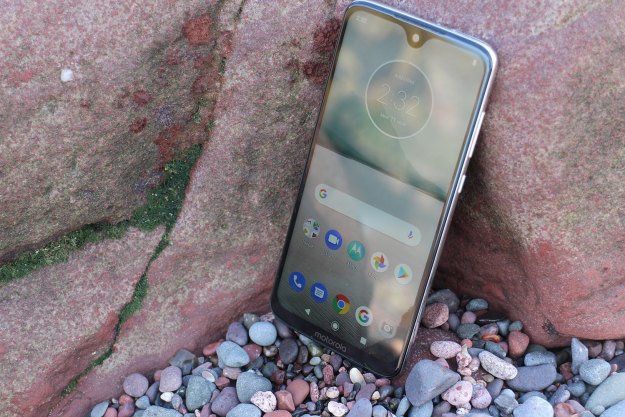
- Good build quality
- Large display
- Solid performance
- Portrait shots are great
- Good value
- No NFC
- Battery life is average
- Camera poor in low light
When Motorola launched the G series back in 2013 it redefined expectations of a budget phone. The first few releases easily retained the budget crown, but the competition is getting much tougher. A resurgent Nokia brand under HMD Global is turning out truly impressive, cheap smartphones; and Honor is not the only threat from the east. Not to mention that Motorola releases so many phones it sometimes feels like it’s competing with itself – this year, there’s a Moto G7 Play, a G7 Power, and a G7 Plus in some markets.
The Moto G7 enters this budget melee confidently, looking every bit the champion. But at $300 it has some work to do to prove its worth, because the original Moto G was just $180. But then this is the age of $1,000 flagships, and what the G7 does that its ancestor could not is pass for a much more expensive phone.
Budget beauty, big display
With a white, curved glass back, a sparkling silvery metal frame, and a large display with a teardrop notch, the Moto G7 looks quite good. It has provoked some admiring glances and even a few enthusiastic comments during the time I’ve been using it, followed by no small surprise at its budget status. Many more expensive phones have failed to get a similar response, but I do feel the white model I received for review is by far the prettiest color option.
The shining M logo on the back doubles as a fingerprint sensor, and Motorola has stuck with its signature, round camera module above, which instantly makes it stand out as a Moto phone. It still protrudes more than I’d like. A case can solve this, though, and it may be well worthwhile considering the glass back.
You’ll find the textured power button on the right spine with a volume rocker above. The bottom edge is home to a USB-C port, flanked by a 3.5mm audio jack and a speaker grill. I’m delighted to see USB-C make its way into budget phones.
The display is large, with a teardrop notch at the top for the front-facing camera. The bezels are slim and there’s a slightly bigger chin at the bottom that bears the Motorola name.
The 6.2-inch LCD screen looks impressive. It’s comfortable to read on and it’s good for watching movies. The resolution is 2,270 x 1,080 pixels, which translates to 403 pixels per inch. That’s actually slightly lower than last year’s Moto G6 which had 424 pixels per inch, but it’s largely because the display is now half an inch bigger, and it’s still sharp enough.
The Moto G7 enters this budget melee confidently, looking every bit the champion.
It doesn’t quite hit the high notes of a major competitor, the Nokia 7.1, which boasts a slightly sharper screen with HDR10 support. If you watch the right content on Netflix or Amazon, you’ll see a difference in quality. What I don’t like about the Moto G7 display is the amount of backlight that comes through in a darkened room. If you watch movies in the dark this can be distracting, but sadly OLED screens have not made it into too many budget phones yet.

The colors aren’t bad, but by default they look pretty saturated. You can tweak the display in the settings if you prefer a more natural look. Brightness can be an issue with budget phones and the Moto G7 is no exception. In direct sunlight, it becomes a little difficult to read what’s on screen, though you can crank that brightness higher if you turn off adaptive brightness in the display settings.
I’m being picky as these criticisms apply to the majority of phones in this price range. The design and display of the Moto G7 are definite high points.
Solid performance with a couple of stumbles
The Moto G7 has a Qualcomm Snapdragon 632 processor inside with 4GB of RAM. That’s a major step up from the Moto G6, which is good because I found last year’s phone sluggish.
It’s clearly a step up on its predecessor in terms of performance.
Swiping around is smooth and apps and games are fairly quick to load. Asphalt 9: Legends does look a bit pixelated, partly because the screen is big and partly because the game chose a lower graphical quality by default. I cranked the visual quality up to see how the Moto G7 handled itself and it did well. There was the occasional dropped frame, but nothing more serious than that.
I also tried out Hello Neighbor which didn’t run well, though that may be down to the game rather than the phone. There were no issues with Super Mario Run.
Here are some benchmark results:
- AnTuTu 3D Bench: 107,389
- Geekbench CPU: 1,259 single-core; 4,813 multi-core
- 3DMark Sling Shot Extreme: 543 (Vulkan)
It’s clearly a step up on its predecessor in terms of performance, but the Moto G7 doesn’t quite hit the same level as the Nokia 7.1, which has the slightly better Snapdragon 636, though it’s not far away.
There’s 64GB of storage available on the Moto G7, which will be plenty for most people, but there’s room for a MicroSD card should you need more space.
Unfortunately, I did encounter a couple of issues with the Moto G7. In the first four days. it crashed three times with no obvious cause. Wi-Fi seemed to cut in and out inexplicably for the first two days and I could unearth no reason in the settings, but then it sorted itself out. The G7 also got stuck in a weird loop where it kept suggesting the battery was low and I should turn on the battery saver, but it was actually plugged in and charging at the time. I had to restart the phone to stop this message popping up. I suspect these issues are down to the software rather than the hardware.
Handy extras versus wobbly performance
The Moto G7 runs Android 9.0 Pie, but with Motorola’s user interface on top and a couple of preinstalled apps – your mileage may vary in this department depending on where you buy the phone. It used to be a point to praise Moto phones for having close to stock Android, but it feels like more and more things have been creeping in and I’m not convinced they’re all useful.
I like some of the camera options, which I’ll get to in the next section. There are lots of Moto Actions to choose from, which are gestures that act as shortcuts. Chop for flashlight and flip for do not disturb are great, but there are some relatively useless options in there too.

There are also display options to keep it on while you’re looking at it, and to peek at and interact with notifications on the lock screen. Moto Voice, which can read your text messages out loud, rounds things out. You may or may not find some of this stuff useful.
What concerns me is a suspicion that the software tweaks actually negatively impact the phone’s performance. I haven’t encountered crashes or other weird issues with Android One phones, for example. While that’s speculative, what’s not in doubt is that Android One phones are guaranteed to get at least two years of Android version updates and three years of security updates. The Moto G7 will likely get Android Q, but beyond that I’m doubtful it will see another update.
Weighing up the extras Moto offers, they’re not worth the problems they bring. Customers would be better served if the Moto G7 was an Android One device, and I’d like to see more budget phones signed up to the program.
It’s also very disappointing to see there’s no NFC support for Google Pay in the U.S. Moto G7 model, which is especially strange as the European version does have it. The $160 Nokia 3.1 Plus has NFC, so there’s really no reason it couldn’t be included here.
Camera is a mixed bag
On paper, the Moto G7 has the same camera suite as the Moto G6, comprising a 12-megapixel lens with an f/1.8 aperture, and a 5-megapixel secondary lens for depth. The front-facing camera is rated at 8-megapixels.
This is a decent camera for the money. If conditions are good with plenty of light, you’ll be able to capture lovely landscape shots or close ups. Colors are quite good and fairly true to life, but it does really struggle with contrast. If there’s a bright area in the scene, it will often be blown out and overexposed.
What I really like about the Moto G7’s camera is the portrait mode, which I think is important to most people because they want to capture great shots of family and friends. It’s not perfect, but it usually creates a good blurred background and comes close to nailing the outline of the subject to keep them in sharp relief. I can forgive the mistakes because the results are generally photos I want to share.
It’s important both subject and photographer are still, however, or you’ll get blurry results. In fact, you’ll generally need a steady hand when snapping photos with the Moto G7 because it lacks optical image stabilization (OIS).

I like some of the extras in the camera app, such as Spot Color, which allows you to tap one color and turn everything else black and white. The Cinemagraph option is also cool, allowing you to make a short animated GIF and choose which area should move, while it freezes the surroundings. It’s tough to get good results though, and it’s the sort of gimmick you might try once and never use again.

On the negative side, low light is a big issue for this camera. It simply can’t capture any detail and things get very noisy, very quickly when darkness falls. I would trade all the gimmicks for better low light performance if I could.
The front-facing camera is perfectly adequate for selfies or video calls. The Moto G7 can also capture 4K and timelapse videos.
Battery life
As you’d expect with a 3,000mAh battery on board, the Moto G7 can make it through an average day just fine. It does have a big screen, though, so nightly charging will be the norm for most people.
In our battery test it managed to run for 8 hours and 27 minutes which is a respectable result.
I’m glad it has a USB-C port for charging, and Motorola’s Turbo Charge standard is fast – you can go from zero to around 80 percent in an hour. It charges fastest between 20 and 80 percent, so you can get a useful amount of juice in just 15 minutes as long as it’s over 20 percent when you plug in.
Sadly, wireless charging has not made its way into the budget phone scene just yet, even though the Moto G7 has a glass back.
Price, availability, and warranty information
The Moto G7 costs $299 and you can buy it direct from Motorola or from retailers like Amazon, Walmart, and Best Buy. You will also find it at Google Fi, Republic Wireless, and Ting.
You get a standard one-year limited warranty for manufacturing defects and faults. If you buy from Motorola, you do have an option to add extended support with Moto Care for another year for $30, or accident protection at $40 for 15 months or $65 for two years, which includes free shipping.
Our Take
The Moto G7 is designed to appeal to everyone with a $300 budget for their next smartphone. It features an attractive design that looks and feels more expensive than it is, with a good display, solid performance, and a mostly decent camera. Software wobbles and that low light camera performance are the big disappointments.
Is there a better alternative?
Yes, the Nokia 7.1 would be our pick as it has Android One, a better camera, and NFC support, though it does cost $50 more.
If you want longer battery life and the camera is not as important, then you can save yourself $50 with the Moto G7 Power. If you don’t mind a cheaper build and smaller screen, then the Moto G7 Play is $100 less.
How long will it last?
You should certainly buy a case if you want the Moto G7 to last. I don’t think you’ll get more than two years from this phone, even if you take care of it, and I worry about the time you may have to wait for software updates.
Should you buy it?
If you like the design and you want a big screen, the Moto G7 could be your best bet at this price. It’s also a great choice for anyone upgrading from older Moto phones, assuming you liked them. If you can scrape together an extra $50, buy the Nokia 7.1 instead.
Editors' Recommendations
- Is the Moto G Stylus waterproof?
- The best Motorola phones in 2024: which one should you buy?
- The best Moto G Power 5G (2024) cases: 7 great choices
- Motorola’s newest cheap Android phone looks shockingly good
- If you like cheap phones, you’ll love these 2 new Moto G options





















